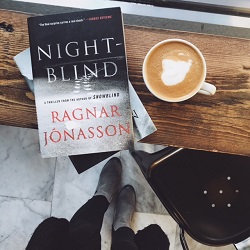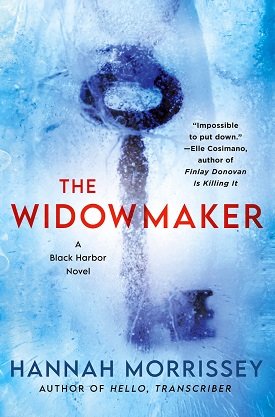Today (12/5/17) is the US publication day for NIGHTBLIND, book two in Ragnar Jonasson’s brilliant Dark Iceland series! The Dark Iceland books have been a personal favorite of mine for quite a while now, and I’m thrilled to see this exceptional series releasing in the US. Every so often, a book (or a whole series) comes along that seems to be doing something genuinely special—Ragnar Jonasson’s Dark Iceland books fall under that category. These atmospheric mysteries take place in a small coastal town in northern Iceland, and seamlessly blend writing reminiscent of classics like Agatha Christie with modern-day plots and tense, chilling crimes. If you’re a newcomer to the Dark Iceland books, you’ve come to the right place: I’m delighted to have Ragnar Jonasson joining me on CBTB today to chat about his unmissable crime fiction series, and its newest installment: NIGHTBLIND.
Before we delve into this Q&A: Ragnar recently shared with CBTB readers a truly unique glimpse into the town that provides the backdrop to this series—make sure to check out our “Photo Tour of Siglufjordur” if you haven’t already! You’ll see exactly what I mean when I say that the Dark Iceland books are made even more special for the part of the world they explore.
Read on for more information about both SNOWBLIND and NIGHTBLIND, and for my Q&A with Ragnar Jonasson!
ABOUT SNOWBLIND & NIGHTBLIND
SNOWBLIND:
Where: A quiet fishing village in northern Iceland, where no one locks their doors. It is accessible only via a small mountain tunnel.
Who: Ari Thor is a rookie policeman on his first posting, far from his girlfriend in Reykjavik. He has a past that he's unable to leave behind.
What: A young woman is found lying half-naked in the snow, bleeding and unconscious, and a highly esteemed elderly writer falls to his death. Ari is dragged straight into the heart of a community where he can trust no one, and secrets and lies are a way of life.
Past plays tag with the present and the claustrophobic tension mounts, while Ari is thrust ever deeper into his own darkness―blinded by snow and with a killer on the loose.
Taut and terrifying, Snowblind is a startling debut from an extraordinary new talent.
NIGHTBLIND:
Ari Thor Arason is a local policeman who has an uneasy relationship with the villagers in an idyllically quiet fishing village in Northern Iceland―where no one locks their doors.
The peace of this close-knit community is shattered by a murder. One of Ari’s colleagues is gunned down at point-blank range in the dead of night in a deserted house. With a killer on the loose and the dark Arctic waters closing in, it falls to Ari Thor to piece together a puzzle that involves a new mayor and a psychiatric ward in Reykjavik. It becomes all too clear that tragic events from the past are weaving a sinister spell that may threaten them all.
Author Q&A: Ragnar Jonasson
Crime by the Book: First of all, thank you so much for taking the time to chat with me! In your own words, could you tell us a little bit about NIGHTBLIND?
Ragnar Jonasson: ‘Nightblind’ is the second in the Dark Iceland series of books and is set some five years after the first book, ‘Snowblind’. We are reunited with Ari Thor and his boss Tómas. The story begins when the local inspector, Herjólfur, is shot while checking on an abandoned house in the middle of the night. Soon Ari Thor’s investigation leads him through a labyrinth of hidden secrets.
CBTB: If you had to describe NIGHTBLIND in three adjectives, which would you choose?
RJ: Dark, cold and gloomy.
CBTB: Your Dark Iceland books (SNOWBLIND, NIGHTBLIND) center around Ari Thor, a young police officer who takes a job in Siglufjordur, a small and quite remote town in northern Iceland. How much of yourself do you see in Ari Thor? Is he someone you relate to?
RJ: I see a lot of myself in Ari Thor. When I started writing his character I made sure he was a few years younger than me, so that I could in part relate to his life, although a lot of his back story is of course purely fiction. But I can mention one thing; in Snowblind he wants to learn to play the piano, and tries to do so. A few years after I wrote the book, I started to learn to play the piano as well.
CBTB: Siglufjordur plays a central role in your books. Not only is it the location for the majority of your stories, but its environment and remoteness become almost like their own character in your stories. What inspired you to set your books in this locale?
RJ: Siglufjörður is a very special town in the northern part of Iceland. It has a lot of history and is also beautiful in its own right. Many Icelanders have strong connections to Siglufjörður as many lived there during the so-called herring era, when the town was the center of herring fishing in Iceland. Everything about Siglufjörður makes it a perfect setting for a crime novel, it is isolated, surrounded by sea and mountains, and a very atmospheric place. I started writing about Siglufjördur in 2009, I simply felt that I had to use this town, which I knew so well, as a setting. My late grandfather had also written a series of books about Siglufjördur, on the history of the town, so in a way I was following in his footsteps, in a different genre though.
CBTB: Speaking of Iceland’s environment: do you find that the dramatic changes in season in Iceland impact your writing? Are you more inspired to write dark, chilling stories during the dark Icelandic winter?
RJ: Yes, it is hard not to be influenced by the seasons here in Iceland. The winter is long, cold and dark. That is simply the reality of our everyday life. My stories wouldn’t be very realistic if I did´t convey this reality in some way. I´m also fascinated by the contrasts in Icelandic nature. It is so magnificent and beautiful but at the same time so harsh and unforgiving. I almost only write during the dark winter nights. In summer, I simply stay outdoors and try to avoid the computer.
CBTB: What are the challenges (or benefits!) of setting a crime novel in a small town like Siglufjordur, rather than a relatively bigger city like Reykjavik?
RJ: The challenges are the constrictions of a small town. It has to be realistic. There are hopefully never going to be multiple crimes committed in such a small town. Everyone knows each other quite well in a small town and there are few places to hide and more difficult to keep secrets. All this gives me limits which I have to work with. My way to deal with this was to focus on the town in Snowblind and Nightblind, but to move the action around northern Iceland in the three subsequent books, although Siglufjörður is always in a way the centerpoint.
CBTB: One of my favorite things about your series is how it blends a Nordic backdrop with a “classic mystery” feel, reminiscent of the work of Agatha Christie. Can you tell us a bit about your personal relationship to Agatha Christie’s work? Was she an inspiration for your own books?
RJ: I used to translate Agatha Christie into Icelandic and she has no doubt had a great influence on my work as a writer. I think I was around 12 when I started reading her books, first in Icelandic and then English, and around 17 when I started translating her novels for an Icelandic publisher. Her strengths lie in plotting and setting. Her plots are usually so clever, with a twist at the end, and the setting was often like a character, such as the Orient Express or the Nile river. I have tried to learn something from her in this respect.
CBTB: I’m sure you receive this question a lot from readers outside Iceland, but I’m so curious - we here in America tend to think of Iceland as an idyllic, very peaceful country, and yet it has a strong tradition of chilling crime fiction - it’s home to yourself, Yrsa Sigurdardottir, and Arnaldur Indridason, among many others! Do you have any theories about why it is that a country with such a low crime rate inspires so many fantastic crime writers? Is it the weather, or is there more to it?
RJ: Although Iceland is a very peaceful place, crimes do exist but on a smaller scale than in other countries, but we also have crimes beneath the surface, something common to all societies, so writers need to address those as well. The bottom line is though simply that human nature is usually the same everywhere, so a crime novel can be set more or less anywhere.
CBTB: When you’re not writing crime fiction, what kinds of books do you enjoy reading? Could you share with us a few books you’ve read recently and enjoyed?
RJ: I read a lot, often many books at a time. I honestly can´t imagine life without books. My favorite genre is of course crime fiction and I´m an avid reader of golden age writers, such as Agatha Christie, Ellery Queen and SS Van Dine. I also enjoy contemporary writers such as PD James, Jo Nesbö, Stieg Larsson, Andrew Taylor, Peter May, Peter Temple, Johan Theorin and Vidar Sundstol. I also, of course, read Icelandic crime fiction, including Yrsa Sigurðardóttir and Arnaldur Indriðason. Other Icelandic authors I enjoy include Audur Ava Olafsdóttir and Olaf Olafsson. When I’m not reading crime fiction I like authors such as Ian McEwan and Colm Tóibín. I would also like to recommend Simon Singh’s Fermat’s Last Theorem for anyone with an interest in mysteries and maths!
CBTB: What are you working on next?
RJ: My latest three books in Iceland have featured a new character, called Hulda, in a series called the Hidden Iceland series, which will appear in English quite soon. This is a trilogy featuring a policewoman in Reykjavik, although the books are set in different parts of the country, and the series is told in reverse. In book one, Hulda is 64, then she is 50 and in the third book she is 40.
Many thanks to Ragnar for taking the time to answer my questions, and to Minotaur for facilitating this Q&A! I received a free review copy of NIGHTBLIND from the publisher; this does not affect my opinion of the book or the content of my post. All opinions my own.
Grab Your Copies of the Dark Iceland Books!
Crime by the Book is a participant in the Amazon Services LLC Associates Program, an affiliate advertising program designed to provide a means for sites to earn advertising fees by advertising and linking to Amazon.com. This in no way affects my opinion of the above books.















Home ownership feel like a distant dream? Zillow listings have you convinced you’ll be renting for the rest of your life? The woman at the heart of Carissa Orlando’s debut The September House feels your pain—and she’s prepared to put up with a lot if it means she and her husband can finally have a place to call their own. In this case, that might just mean living in a house that’s haunted. Playful and irreverent, spine-tingling and spooky, The September House puts a fresh spin on the classic haunted house story, delivering an immersive tale about the secrets lurking within one building’s walls, and within the lives of its inhabitants.